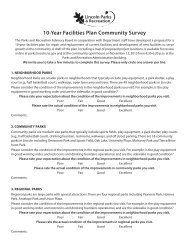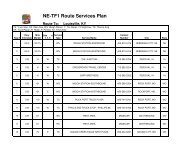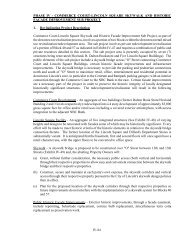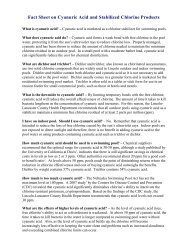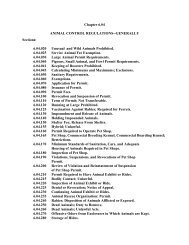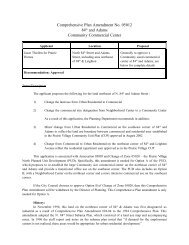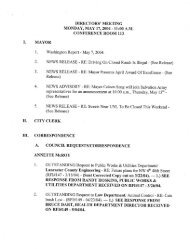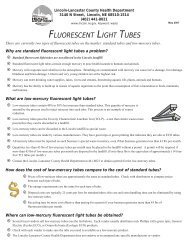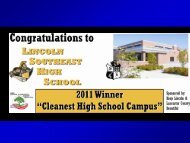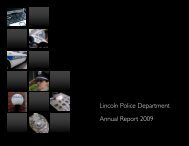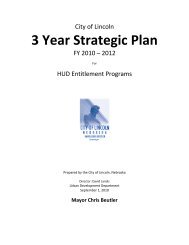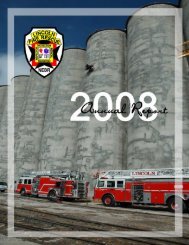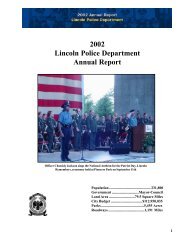It's time to think about refurbishing and updating existing ...
It's time to think about refurbishing and updating existing ...
It's time to think about refurbishing and updating existing ...
You also want an ePaper? Increase the reach of your titles
YUMPU automatically turns print PDFs into web optimized ePapers that Google loves.
Please share any comments you have regarding l<strong>and</strong> use patterns <strong>and</strong> development.<br />
<strong>It's</strong> <strong>time</strong> <strong>to</strong> <strong>think</strong> <strong>about</strong> <strong>refurbishing</strong> <strong>and</strong> <strong>updating</strong> <strong>existing</strong> infrastructure as well as repurposing buildings in<br />
addition or in leui of just building new stuff.<br />
Smarter in-fill design, rather than sprawl, should be a priority. Our region benefits from both urban <strong>and</strong><br />
natural/agricultural areas.<br />
I'm not very studied on these issues but generally <strong>think</strong> Lincoln has a nice balance of open spaces <strong>and</strong> isn't<br />
overdeveloped, as well as considers preserving natural areas. I'd hope we can keep it that way.<br />
Green spaces are SUPER important for the mental <strong>and</strong> physical health of a population. Please keep them natural<br />
<strong>and</strong> spacious.<br />
More green spaces, walking, <strong>and</strong> cycling should be made more of a priority. Redevelopment of old buildings <strong>and</strong><br />
areas would be better than <strong>to</strong> develop new areas. Preserve more riparian areas <strong>to</strong> help integrate wildlife with<br />
the city <strong>and</strong> <strong>to</strong> breakup the mono<strong>to</strong>ny of the urban l<strong>and</strong>scape. A city that avoids so much traffic congestion <strong>and</strong><br />
car use would be wonderful.<br />
Lincoln seems <strong>to</strong> have a nice balance as far as I experience it.<br />
Developments,including public (schools) use expansive tracts of l<strong>and</strong> with less public revenue generated per<br />
acre than there should be. This expansive (less dense) use dem<strong>and</strong>s public infrastructure (streets, water, sewer,<br />
electricity, transit, etc.) at a higher cost per acre than a denser more sustainable l<strong>and</strong> development.<br />
Too many <strong>time</strong>s special interests or certain people get lots of breaks. System is unfair <strong>and</strong> not administered in<br />
the same way <strong>to</strong> all people.<br />
Balance slow outward growth with revitalization of the <strong>existing</strong> urban core. Newer developments should be<br />
more like Fallbrook- pedestrian oriented with some routine err<strong>and</strong>s (e.g., groceries) within walking distance of<br />
the residence.<br />
Wish you wouldn't have caved in <strong>to</strong> home builders & developers dem<strong>and</strong>s on making future development less<br />
dense than proposed when the public was in favor of more dense development (Plan 2040)... Lincoln should aim<br />
for smart growth <strong>and</strong> not be another Omaha or LA.<br />
I feel that we need <strong>to</strong> preserve the Natural Areas but let’s not confuse that with park l<strong>and</strong>. We have seen a<br />
situation recently that because of budget restraints the city cannot afford <strong>to</strong> maintain or improve park l<strong>and</strong>. The<br />
point is that we can preserve natural areas but keep the maintenance in the h<strong>and</strong>s of the developer or HOA.<br />
How do you control or balance urban sprawl? The taking of ag l<strong>and</strong> for housing, good luck.<br />
We have a planning department? Would not appear so over the last decade.<br />
I <strong>think</strong> parking lots are generally <strong>to</strong>o big, but especially down<strong>to</strong>wn. That reality may not actually be something<br />
that is within this particular entity's control, but overall I feel that there are parking lots or empty concrete areas<br />
that exist solely for the eight weeks of the year that there are football games in Lincoln. I could be wrong <strong>about</strong><br />
this--I'm sure there are studies <strong>and</strong> intelligent people designing parking lots who underst<strong>and</strong> how many spots are<br />
needed for the number of people working nearby--but since the survey asks me what I <strong>think</strong>, that's what I <strong>think</strong>!<br />
Efficient use of available l<strong>and</strong> is a great ideal but the city must balance l<strong>and</strong> use planning with citizen property<br />
rights <strong>and</strong> make sure <strong>to</strong> preserve ag l<strong>and</strong> <strong>and</strong> natural areas in a way which does not inhibit business<br />
development. I don't see a reason for the city <strong>to</strong> work at preserving agricultural l<strong>and</strong>. Farmers <strong>and</strong> people in the<br />
Ag industry will make sure they have enough <strong>and</strong> suitable quality l<strong>and</strong> <strong>to</strong> carry out their business. The city does<br />
not need <strong>to</strong> give them special incentives <strong>to</strong> cultivate their own l<strong>and</strong> or keep it as a farm - if it makes more<br />
economic sense <strong>to</strong> sell the l<strong>and</strong> for non agricultural purposes then there must not be a need for agricultural l<strong>and</strong>.<br />
Keep a wide green corridor around the hiking/biking trails. Allow shelter belts <strong>to</strong> grow around developments in<br />
both residential <strong>and</strong> commercial areas. Include more green "commons" areas in neighborhoods or bigger yards<br />
around houses. Apartment complexes are <strong>to</strong>o big, <strong>to</strong>o high, <strong>and</strong> have no trees, yards, or shelter belts.<br />
Commercial buildings are being built <strong>to</strong>o close <strong>to</strong> the streets. The overall impression is that Lincoln is becoming<br />
more urban, more paved, less treed <strong>and</strong> less green.
Anything done must be bicycle friendly. I was promised the arena development would be but have seen zero<br />
info on this. If it is not, my vote will be carefully considered on all future projects.<br />
Too much sprawl -- not enough in-fill. I vote for density over sprawl. Parks often in poor repair <strong>and</strong> give cars &<br />
drivers priority over cyclists <strong>and</strong> pedestrians. Provide cycling <strong>and</strong> walking options for all new developments.<br />
Should be able <strong>to</strong> bicycle safely <strong>to</strong> every park in the city.<br />
Ag development procedures need <strong>to</strong> be updated, you need a current well test <strong>to</strong> assure that there is adequate<br />
water for the new homeowner <strong>and</strong> <strong>existing</strong> neighbors. Submitting an old test from the 70's or 80's in no way<br />
compares <strong>to</strong> <strong>to</strong>days water usage. Lack of water availabilty is in the forefront of the news <strong>to</strong>day but we continue<br />
<strong>to</strong> allow 3 acre developments with no infrastruture support. You should not be allowed <strong>to</strong> get an AGR zoning<br />
change without a plat being submitted. Allowing homes <strong>to</strong> be crammed on an <strong>existing</strong> homestead looks<br />
mismatched & would not be allowed in the city limits as it looks out of place.<br />
I was very disappointed that the issue on buying future park l<strong>and</strong> for the exp<strong>and</strong>ing city didn't pass (I guess an<br />
arena for a few people is more important than a park for everyone these days). I am pleased <strong>to</strong> see that the city<br />
is getting away from mowing every acre <strong>and</strong> has gone <strong>to</strong> natural grasses in some places. Also seem <strong>to</strong> recall that<br />
there is some consideration of allowing more community gardening. If not, there should be as it seems<br />
reasonable <strong>to</strong> do so. I underst<strong>and</strong> the concern for building up high tax value commercial areas but would also<br />
hope that more attention is paid <strong>to</strong> some of the residential blighted areas. That <strong>and</strong> taking l<strong>and</strong>owners <strong>to</strong> task<br />
for not keeping up their properties. Maybe some of those should be taken by imminent domain <strong>and</strong> changed<br />
in<strong>to</strong> mini-park or community garden areas if they can't be brought up <strong>to</strong> speed otherwise.<br />
I do NOT feel just because the is st<strong>and</strong>ing water in a field the government should be able <strong>to</strong> come on<strong>to</strong> private<br />
property <strong>and</strong> declare it <strong>to</strong> be a watershed area <strong>and</strong> take that away from a farmer <strong>to</strong> use as he sees fit.<br />
Lincoln's preservation of natural areas through park systems (such as Wilderness <strong>and</strong> Pioneers) makes it great <strong>to</strong><br />
live here. The biggest area for improvement in Lincoln according <strong>to</strong> my experiences living in other communities<br />
is developing the down<strong>to</strong>wn. People who live near the down<strong>to</strong>wn area have <strong>to</strong> drive out <strong>to</strong> the edges of <strong>to</strong>wn <strong>to</strong><br />
have options for grocery shopping <strong>and</strong> buying other goods <strong>and</strong> services. Finding a way <strong>to</strong> revitalize the<br />
down<strong>to</strong>wn <strong>and</strong> draw businesses back <strong>to</strong> this area would make Lincoln more pedestrian friendly, environmentally<br />
responsible, <strong>and</strong> vibrant.<br />
The current plan seems <strong>to</strong> discourage growth, will eventually raise taxes <strong>and</strong> cause people <strong>to</strong> live in nearby<br />
communities <strong>and</strong> still work in <strong>and</strong> around Lincoln. I would like <strong>to</strong> see infrastructure for growth looked at <strong>and</strong><br />
prioritized rather than being avoided. I don't disapprove of growth in the core, but feel all options should be<br />
available for the individual families <strong>to</strong> decide what is best for them. Public safety, responsible development <strong>and</strong><br />
construction is still important, but growth serves everyone <strong>and</strong> allows us <strong>to</strong> enjoy our libraries, parks, pools, etc.<br />
What are our 10-30 plans for water, sewage, etc. are we buying the necessary l<strong>and</strong> before it is developed? We<br />
need <strong>to</strong> be responsible <strong>and</strong> educate the public <strong>about</strong> our resources, but should a drought s<strong>to</strong>p us in our tracks? If<br />
it does, there has been a lack of planning involved. City/State is run fairly well, but there is always room for<br />
improvements. Thank you for looking & asking!<br />
I don't like sprawl, but it seems we've been doing better at avoiding that.<br />
Too much urban sprawl.<br />
Some<strong>time</strong>s the preservation of natural l<strong>and</strong> takes priority over the use of the l<strong>and</strong>.<br />
I <strong>think</strong> there is still considerable room for improvement in the area of City support for development of<br />
unimproved <strong>and</strong> blighted l<strong>and</strong> within the city limits, <strong>and</strong> particularly blighted/unimproved l<strong>and</strong> within the<br />
Down<strong>to</strong>wn <strong>and</strong> Haymarket vicinities.<br />
growing is good, but not sprawling. We better <strong>to</strong> have an efficient <strong>and</strong> effective city size.
Our l<strong>and</strong> should be used environmentally sustainably. Urban areas should be well-planned, efficient, <strong>and</strong><br />
compact (no sprawl). Rural areas shouldn't be filled with mono-culture crops doused with petroleum-based<br />
sprays. Diverse, native wildlife <strong>and</strong> small-scale, local agriculture should fill our rural areas. I know that Lincoln /<br />
Lancaster County is working <strong>to</strong>wards at least some of those goals as part of LPlan2040 (bike corridor, etc), which<br />
makes me really excited.<br />
The proposed new ice rink should not be located in Lincoln's down<strong>to</strong>wn floodplain. This will add a foot of water<br />
over 35 acres of the Haymarket <strong>and</strong> South Bot<strong>to</strong>ms His<strong>to</strong>ric District when we reach flood stage on Salt Creek.<br />
Loved <strong>to</strong> see the more natural ideas in the parks when mowing was reduced. Also liked that the grasses filtered<br />
the waterways thru those areas. Would like <strong>to</strong> see more areas planted with natural types of grasses/wildflowers<br />
<strong>to</strong> promote birds/bees, etc.<br />
Residential l<strong>and</strong> use in the city is pretty efficient, but commercial development not as much with lots of one<br />
s<strong>to</strong>ry buildings <strong>and</strong> lots of parking. The county has <strong>to</strong>o many exceptions <strong>to</strong> what would otherwise be pretty<br />
efficient regulations.<br />
Given the amount of <strong>existing</strong> open, available commercial space, I am continually puzzled that we must build<br />
even more.<br />
The Hwy 77 bypass is a very efficient way of moving from I-80 <strong>to</strong> southern Lincoln, but it certainly cut up many<br />
farms <strong>and</strong> made their l<strong>and</strong> less useful. The proposed south bypass will do the same--rather than widening<br />
<strong>existing</strong> roads <strong>to</strong> make them one-ways south/west <strong>and</strong> north/east. Having such roads a mile apart would not be<br />
unmanageable. Preservation of natural areas is very good--such as Wilderness Park <strong>and</strong> the bike paths. Efforts<br />
should be made <strong>to</strong> pursuade contrac<strong>to</strong>rs <strong>to</strong> set aside parts of each development as a natural/wildlife area. Even<br />
in the city, we need <strong>to</strong> preserve natural habitat for various creatures.<br />
I'd like <strong>to</strong> curtail urban sprawl, <strong>and</strong> encourage more development in the already built-up parts of the city. Many<br />
older neighborhoods have deteriorating structures than can be demolished <strong>and</strong> replaced by new ones, helping<br />
<strong>to</strong> revitalize the core of the city.<br />
I <strong>think</strong> that realistic agricultural l<strong>and</strong> values <strong>and</strong> locations should be used <strong>to</strong> establish zoning criteria. I <strong>think</strong> that<br />
the concepts of industrial parks <strong>and</strong> commercial areas need <strong>to</strong> be developed <strong>to</strong> make them available <strong>to</strong> but not<br />
intrude in<strong>to</strong> residential areas. Residential zoning may need <strong>to</strong> be revised <strong>to</strong> permit variation, for example, in set<br />
back <strong>and</strong> building separations. The issue of residential blight probably needs guidelines for adequate control <strong>and</strong><br />
or enforcement. Bob Mitchell (3 – 15 – 2013)<br />
I <strong>think</strong> that realistic agricultural l<strong>and</strong> values <strong>and</strong> locations should be used <strong>to</strong> establish zoning criteria. I <strong>think</strong> that<br />
the concepts of industrial parks <strong>and</strong> commercial areas need <strong>to</strong> be developed <strong>to</strong> make them available <strong>to</strong> but not<br />
intrude in<strong>to</strong> residential areas. Residential zoning may need <strong>to</strong> be revised <strong>to</strong> permit variation, for example, in set<br />
back <strong>and</strong> building separations. The issue of residential blight probably needs guidelines for adequate control <strong>and</strong><br />
or enforcement. Bob Mitchell (3 – 15 – 2013)<br />
S<strong>to</strong>p wasting money <strong>and</strong> resources on the Salt Creek Tiger Beetle <strong>and</strong> other so called rare creatures. They do<br />
absolutely no good for the human race.<br />
Developers should preserve the <strong>existing</strong> natural areas onsite <strong>and</strong> work them in<strong>to</strong> the design of the<br />
development. Too often, they add amenities (water features <strong>and</strong> trees) after they have destroyed the l<strong>and</strong>scape.<br />
There seems <strong>to</strong> be <strong>to</strong>o much reusable space within <strong>existing</strong> neighborhoods <strong>to</strong> develop before extending <strong>to</strong> the<br />
suburbs <strong>and</strong> having <strong>to</strong> put in infrastructure <strong>and</strong> add <strong>to</strong> city services such as police <strong>and</strong> fire. Redevelopment<br />
makes more sense rather than extending out in<strong>to</strong> the county.<br />
Lincoln/Lancaster county need <strong>to</strong> facilitate more expansion on the edges of city limits <strong>and</strong> do better of planning<br />
<strong>and</strong> developing street systems outside of city limits <strong>to</strong> provide for future expansion.<br />
Sell city property that is idle <strong>and</strong>/or not generating income. Reinvest in infrasture <strong>and</strong> streets.<br />
Care should be taken when looking at developing outside current city boundaries without first identifying how<br />
infrastructure will be provided <strong>and</strong> paid for. Impact fees were voted in but now our leaders are not willing <strong>to</strong> use<br />
this funding source as intended.
The city seems <strong>to</strong> create more park l<strong>and</strong> than it can afford <strong>to</strong> maintain. When the Sunken Gardens needed <strong>to</strong> be<br />
refurbished the city couldn't afford <strong>to</strong> do it <strong>and</strong> had <strong>to</strong> raise donations. The new park along Antelope Creek also<br />
is being funded by private donations. Until the city can afford <strong>to</strong> h<strong>and</strong>le what it already has I <strong>think</strong> that it should<br />
forgo adding new "natural areas".<br />
Lincoln lacks a large industrial section <strong>to</strong> attract future employers. We spend <strong>to</strong>o much money on making the<br />
city beautiful instead of attractive <strong>to</strong> larger corporations. One difference between Lincoln <strong>and</strong> Omaha is that<br />
Lincoln lacks a Fortune 500 company. What is the opposite of growth?<br />
Lincoln has plenty of room <strong>to</strong> grow <strong>and</strong> develop on the outskirts of <strong>to</strong>wn. The concerted effort <strong>to</strong> "do it<br />
down<strong>to</strong>wn" while laudable for a <strong>time</strong> is frankly,now overdone. There is no reason why available l<strong>and</strong> shouldn't<br />
be utilized on the edges of <strong>to</strong>wn for natural growth <strong>and</strong> development especially as a city that purports itself as<br />
one that wants <strong>to</strong> "be business friendly." Additionally l<strong>and</strong> prices,rents go up in the core neighborhoods when<br />
<strong>to</strong>o much new development happens which actually is detrimental <strong>to</strong> the poor <strong>and</strong> disenfranchised. Lincoln has<br />
a good mix now but it is starting <strong>to</strong> tip <strong>to</strong>o far in the direction of core neighborhood development <strong>and</strong> "in-fill"<br />
within the city limits. Time <strong>to</strong> re-balance <strong>and</strong> let outskirts development continue. Government's role in this area<br />
should be very limited <strong>and</strong> only asserted when a compelling interest is there, not a trumped up one or one that<br />
is lobbied the hardest for (ala the Down<strong>to</strong>wn Lincoln Association) asserting disproportion <strong>and</strong> undue influence.<br />
Review of all zoning would be good-just <strong>to</strong> keep things like what happened on S27th from happening in the<br />
future-- <strong>and</strong> East on Old Cheney.<br />
Elected City leaders need <strong>to</strong> be on record as being for or against growth, by voting on a growth plan that has<br />
solid <strong>time</strong>lines <strong>and</strong> just not a piece of paper.<br />
The city can not have it both ways. To limit urban sprawl but also try <strong>and</strong> limit l<strong>and</strong> use requires zero growth.<br />
That is the wrong direction for a strong vibrant city.<br />
Planning makes unsustainable policies. Such as infill - however all a neighborhood has <strong>to</strong> do is complain <strong>and</strong><br />
then Planning turns against the developer/builder. Existing policies don't encourage new building types, parking,<br />
lighting, signs, or size of new buildings<br />
There is still a lot of room for development <strong>and</strong> preservation of natural areas can still be done within these<br />
limits <strong>to</strong>o.<br />
We need the city <strong>to</strong> allow expansion <strong>to</strong> allow for affordable housing<br />
Preserving Wilderness <strong>and</strong> creating parks that are preserved spaces is very important <strong>and</strong> somewhat well done<br />
by the city but Wilderness Park is a citizen run project so less impressive for the city.<br />
The three L<strong>and</strong> Use <strong>to</strong>pics are not defined. Each could mean several different things. Therefore, any use of this<br />
survey <strong>to</strong> make a determination of what the citizens want is null <strong>and</strong> void.<br />
We need <strong>to</strong> make sure we preserve park space. We also need <strong>to</strong> plan for non-mo<strong>to</strong>rized traffic for those who<br />
can't or don't want <strong>to</strong> drive. We need <strong>to</strong> plan for bike routes <strong>and</strong> pedestrian traffic in new developments <strong>and</strong><br />
retrofit some neighborhoods that neglected these issues.<br />
I would encourage the city of Lincoln <strong>to</strong> continue expending its current limits.<br />
Lincoln is surrounded by rich farml<strong>and</strong> that previously didn't need irrigation. Lincoln is <strong>to</strong>o interested in growth<br />
& should be more concerned w/ what incentives would keep people in <strong>to</strong>wn rather than wasting good farml<strong>and</strong><br />
w/ acreages.<br />
Efficiency is market driven. If it is government or central planning driven, it is not done efficiently.<br />
I would like <strong>to</strong> see Lincoln develop east. We have grown in every direction but east.<br />
I have noticed farms in <strong>to</strong>wn. That is odd. 33rd street from cornhusker <strong>to</strong> Superior is a somewhat large area of<br />
l<strong>and</strong> <strong>and</strong> it seems that the city has not utilized it at all. Not <strong>to</strong> mention if 33rd went all the way north it could<br />
ease some of the traffic on 27th, 48th. making half the city's lives a little less stressful.<br />
I believe the concentric growth of Lincoln is a huge positive for our community <strong>and</strong> I support that policy.
"Efficient Use of Available L<strong>and</strong>" means <strong>to</strong> me that the l<strong>and</strong> owner has primary control over how his l<strong>and</strong> should<br />
best be used! Preservation of Agricultural L<strong>and</strong> <strong>and</strong> Natural Areas should not be dictated by government <strong>to</strong> the<br />
detriment of economic growth of the community.<br />
We are in a rural setting that a majority of our residents want <strong>to</strong> live in a single family dwelling. This requires the<br />
mix of l<strong>and</strong> uses <strong>to</strong> accommodate those choosing <strong>to</strong> live in the core with those who moved <strong>to</strong> a rural area of the<br />
US <strong>to</strong> have their own type of castle with a piece of l<strong>and</strong>.<br />
you keep filling in wetl<strong>and</strong>s<br />
We live in an area that is very l<strong>and</strong> abundant. We need <strong>to</strong> put resources in<strong>to</strong> effecient structures <strong>and</strong> not l<strong>and</strong><br />
I answered the second question all neutrals because you didn't have an option for "The city should butt out <strong>and</strong><br />
let l<strong>and</strong> owners <strong>and</strong> businesses <strong>and</strong> the market decide how l<strong>and</strong> gets used." As for the first question, I'm fine<br />
with the parks we have, we don't need the city doing a bunch of this stuff. For farms, there's always going <strong>to</strong> be<br />
farms around, it's freaking Nebraska. As for efficiency, the city is the ABSOLUTE LAST people that should be<br />
trying <strong>to</strong> tell others how <strong>to</strong> do things "efficiently".<br />
It is important <strong>to</strong> preserve natural areas so that people can get out in them <strong>to</strong> relax, picnic, hike <strong>and</strong> deepen<br />
their relationship with Jesus.<br />
Are you asking if you can conscript private l<strong>and</strong> for government use? Just compensation is required <strong>and</strong> must be<br />
for a very important civic reason. Crowding people in<strong>to</strong> the center core is not only bad environmental policy but<br />
is silly owing <strong>to</strong> the vast l<strong>and</strong> we have been blessed with. The decisions for the above rest with the decisions of<br />
the persons owning the property.<br />
Are you asking if you can conscript private l<strong>and</strong> for government use? Just compensation is required <strong>and</strong> must be<br />
for a very important civic reason. Crowding people in<strong>to</strong> the center core is not only bad environmental policy but<br />
is silly owing <strong>to</strong> the vast l<strong>and</strong> we have been blessed with. The decisions for the above rest with the decisions of<br />
the persons owning the property.<br />
Maintaining property values in <strong>existing</strong> residential areas is very important, which means being smart <strong>about</strong> what<br />
commercial or other development is permitted in residential areas.<br />
I am concerned <strong>about</strong> outside influences over l<strong>and</strong> use effecting our decisions. We need balance <strong>and</strong> growth<br />
<strong>and</strong> must be careful not <strong>to</strong> be driven by others' agendas. Thank you for not yet joining the Agenda 21 group as<br />
Omaha has done... I am not completely opposed <strong>to</strong> their goals but want <strong>to</strong> be certain <strong>to</strong> maintain LOCAL control<br />
<strong>and</strong> not cede it <strong>to</strong> others. Thanks! You have a <strong>to</strong>ugh job <strong>and</strong> I appreciate your hard work.<br />
Too much being set aside for wilderness/prairie/habitat <strong>and</strong> interfering with the housing <strong>and</strong> commercial<br />
development.<br />
The City <strong>and</strong> LPS are incentivizing urban sprawl. Need <strong>to</strong> have developers pay their fair share when they are<br />
spreading out our services. Provide incentives for redevelopment in older areas. The voice of the homebuilders<br />
<strong>and</strong> developers has his<strong>to</strong>rically won out over community interests.<br />
Creating a new park in the NW of Lincoln is finishing the choke chain <strong>to</strong> prevent development for all.<br />
I wish the interstate had not been built north of <strong>to</strong>wn encroaching on salt marsh habitat. I hate the 27th Street<br />
interchange <strong>and</strong> hope development can be slowed on the north side of <strong>to</strong>wn. I love the older neighborhoods in<br />
<strong>to</strong>wn.<br />
I don't quite underst<strong>and</strong> the idea of tearing down every building on a site <strong>to</strong> put up a new one. I underst<strong>and</strong> it is<br />
the sellers option, <strong>and</strong> most of the chains want their own footprint, but really? Tearing down perfectly good<br />
solid buildings. I also don't underst<strong>and</strong> the need for all of the CVS s<strong>to</strong>res going in while we already have an<br />
abundance of Walgreens <strong>and</strong> CVS. Worry <strong>to</strong>o much <strong>about</strong> big box s<strong>to</strong>res, when I feel we are being invaded by<br />
these others <strong>and</strong> all they employee are many part <strong>time</strong> people without benefits. Not sure how that helps Lincoln<br />
Would like <strong>to</strong> see more established green spaces available for public use <strong>and</strong> enjoyment.<br />
It seems as if Lincoln is in an eternal sprawl, especially <strong>to</strong> the south. Other than the Haines Branch right of way<br />
which will be protected <strong>and</strong> made in<strong>to</strong> a path, I'm not aware of plans <strong>to</strong> preserve natural areas in that direction,<br />
or any.
I <strong>think</strong> that the sprawling of our city creates problems with transportation <strong>and</strong> especially with an increase in<br />
fossil-fuels use.<br />
I would like <strong>to</strong> see more investment in urban areas prior <strong>to</strong> building on the city edges.<br />
you must not have spellcheck...<br />
would be good <strong>to</strong> move <strong>to</strong>ward conservation design of new developments with the next comprehensive plan<br />
Eliminate density caps <strong>and</strong> height limitations on newly developing areas <strong>to</strong> encourage efficient use of<br />
infrastructure. Reduce parking requirements(developers/tenants/buyers will require sufficient parking <strong>to</strong> be<br />
competitive <strong>and</strong> efficient).<br />
Lincoln has a number of great parks <strong>and</strong> golf courses. It is important not only <strong>to</strong> preserve <strong>and</strong> fund maintenance<br />
for those treasures but <strong>to</strong> plan for future parks out along the perimeter of the city <strong>and</strong> consider l<strong>and</strong> acquisition<br />
or possibly promote social or planned giving <strong>to</strong> the current owners. Regardless, development will take the l<strong>and</strong> if<br />
the City <strong>and</strong> County are not proactive.<br />
The question is presented poorly. I <strong>think</strong> efficient use would be an interpreted response, without siceince <strong>and</strong><br />
with bias. I wish tath l<strong>and</strong> was less constricted in use.<br />
Need <strong>to</strong> foster more in-fill <strong>and</strong> growth in City's core<br />
Unfortunately it's still cheaper <strong>to</strong> develop a cornfield than <strong>to</strong> rehab a whole city block in the near down<strong>to</strong>wn<br />
areas. Economic incentives should be in place <strong>to</strong> encourage the latter, so more young professionals will find neardown<strong>to</strong>wn<br />
housing <strong>and</strong> other offerings attractive.<br />
Lincoln codes most certainly seem <strong>to</strong> dem<strong>and</strong> far excessive parking!, QUESTION:, If parking requirements aren't<br />
excessive, how on earth can so many box-s<strong>to</strong>res have half of their parking lot consumed by nursery plants <strong>and</strong><br />
related l<strong>and</strong>scape s<strong>to</strong>ck for two months every year <strong>and</strong> not be short on parking?, ANSWER:, Parking IS excessive,<br />
but required by the City. Excessive parking lot pavements required by the City are probably the worst use of<br />
space possible!<br />
I don't know enough <strong>about</strong> Lincoln/Lancaster Co's l<strong>and</strong> use <strong>to</strong> form an opinion. I appreciate the park/green<br />
space within <strong>and</strong> around the city. I strongly dislike the fact that the Bison trail is closed at the Van Dorn bridge.<br />
This prevents our family from biking <strong>to</strong> Pioneers. I like the more recent developments, <strong>and</strong> preserving down<strong>to</strong>wn<br />
<strong>and</strong> core areas of the city. I do not like the sprawling suburban areas that look very generic.<br />
Anything that makes this already amazing city friendlier <strong>to</strong> pedestrians <strong>and</strong> those who forego al<strong>to</strong>gether the use<br />
of an au<strong>to</strong>mobile is that which I heartily support.<br />
It appears very easy <strong>to</strong> modify the Domprehensive Plan <strong>and</strong> advance areas in later tiers <strong>to</strong> Tier1<br />
Sustainable floodplain policies are extremely important. Protection of <strong>existing</strong> neighborhoods from street<br />
widening, ugly LES overhead lines <strong>and</strong> four corner development or encroachment of business districts should<br />
also be prioritized.<br />
S<strong>to</strong>p developing for growth in Lincoln. Due <strong>to</strong> the loss of employment opportunities, retire leaving, high taxes,<br />
<strong>and</strong> high cost of university; people are leaving <strong>and</strong> are going <strong>to</strong> continue <strong>to</strong> leave Lincoln. I would have never<br />
thought i would live <strong>to</strong> see the day Gr<strong>and</strong> Isl<strong>and</strong> is out pacing Lincoln. So sad.<br />
I believe strongly in creating a greenbelt around the city. I <strong>think</strong> building roads further <strong>and</strong> further out is exactly<br />
the wrong course of action is actually fiscally irresponsible going forward. Nebraska is mostly agricultural l<strong>and</strong> so<br />
we should invest our tax dollars in saving some green space around the current city limits <strong>and</strong> direct<br />
development inward in infill projects that serve the communities that already here. We could be a national<br />
example with some work!<br />
Res<strong>to</strong>ring <strong>existing</strong> neighborhoods would be much better than allowing for outward growth with new<br />
I encourage more efforts for wise use of l<strong>and</strong> use patterns <strong>to</strong> preserve natural areas, preservation of agricultural<br />
l<strong>and</strong> <strong>and</strong> efficient use of available l<strong>and</strong>.
Repeatedly I have heard from out-of-<strong>to</strong>wn visi<strong>to</strong>rs that they are shocked at the lack of public l<strong>and</strong>s in general<br />
(outside of city parks). Wonderful project <strong>to</strong> do prairie greenspace corridor. The future will be diffferent <strong>and</strong> it is<br />
critically important that plentiful agricultural l<strong>and</strong>s <strong>and</strong> natural areas are here - we can't go wrong with<br />
prioritizing that for future generations in addition <strong>to</strong> ourselves.<br />
We should have more l<strong>and</strong> dedicated <strong>to</strong> flood control <strong>and</strong> retention.<br />
There is suburban sprawl developing all over south Lincoln, while large areas of O street <strong>and</strong> other business<br />
areas in the middle of <strong>to</strong>wn are vacant. The building <strong>and</strong> planning seems <strong>to</strong> be development <strong>and</strong> business driven,<br />
rather than placing a priority on creating green spaces or addressing the character <strong>and</strong> quality of Lincoln.<br />
I appreciate a remark our planning direc<strong>to</strong>r made a couple of years ago that we have enough planned <strong>and</strong><br />
plotted developments <strong>to</strong> last us for twelve years. Efforts <strong>to</strong> preserve the core of the city <strong>and</strong> balance our growth<br />
are appreciated.<br />
Ag l<strong>and</strong> is protected by acreage rules, however housing developments in ag l<strong>and</strong> shouldn't be allowed outside<br />
the city limits.<br />
Although the 2040 plan calls for infill of areas in the city, I do not see much happening.<br />
"efficient use" could mean anything--like develop the heck out of every square inch which I do not <strong>think</strong> is<br />
smart. We need livable, walk-able neighborhoods, with shops schools <strong>and</strong> parks easily accessible.<br />
Developers are souless adherants <strong>to</strong> the profit motive. Fact. I was an at<strong>to</strong>rney in private practice representing<br />
them. Trust me. Souless.<br />
"Preservation of Agircultural L<strong>and</strong>" (How embarrassing! I'd invest in another spelling verifier.) I <strong>think</strong> <strong>to</strong>o much<br />
of the natural habitat for wildlife on Lincoln's outskirts is being developed in<strong>to</strong> residential areas. Sections of<br />
former farml<strong>and</strong> are being sold off in<strong>to</strong> residential packages, displacing deer, coyotes, <strong>and</strong> other inhabitants of<br />
the areas. Increased traffic because of these residential outcroppings is also a danger <strong>to</strong> these animals.<br />
Overall <strong>and</strong> in general, I <strong>think</strong> Lincoln has done well in comparison <strong>to</strong> Omaha, Kearney, Gr<strong>and</strong> Isl<strong>and</strong> <strong>and</strong> other<br />
sprawling communities in the state. I am encouraged <strong>to</strong> see more mixed use areas in new development. We<br />
need <strong>to</strong> be looking ahead realistically at the fact our old habits, dependent on abundant, cheap fossil fuel, will no<br />
longer be possible, if we have the sense <strong>to</strong> respond intelligently <strong>to</strong> mitigate climate change. We need <strong>to</strong> increase<br />
the proportion of park l<strong>and</strong> in new developments. Important natural areas such as tallgrass prairie, streams <strong>and</strong><br />
floodplain areas should not be developed, <strong>and</strong> they should be protected well in advance so developers know<br />
what <strong>to</strong> expect.<br />
In combination with smart <strong>and</strong> efficient l<strong>and</strong> use, sturdy native Nebraska trees are vital <strong>to</strong> beautification,<br />
appeal, recreation, <strong>and</strong> coolness of the city. Trees assist in cleaning the air <strong>and</strong> reduce CO2 emissions. If there<br />
are open grass easements along roadways, railways, parks, or streets that do not have trees growing, there<br />
would be value in planting of trees in these areas. Lincoln could have an even greater appeal <strong>to</strong> have an obvious<br />
<strong>and</strong> noticeable amount of trees planted. The city has done much work in planting trees, but I noticed last<br />
summer that many dried up. The trees outside Leon's Grocery on 30th <strong>and</strong> South street is an example. Perhaps<br />
there could be a more secure plan in place <strong>to</strong> see those trees are watered in their tender growth years.<br />
I would like <strong>to</strong> see older homes renovated before Lincoln develops a lot of new neighborhoods. I would also like<br />
<strong>to</strong> see less <strong>and</strong> smaller acreages.<br />
I feel that Lincoln is constantly exp<strong>and</strong>ing outwards <strong>and</strong> that we should be focused on building up rather than<br />
building out. I feel that the policy that no building shall be taller than the capi<strong>to</strong>l is ridiculous <strong>and</strong> inhibits our<br />
ability <strong>to</strong> use available l<strong>and</strong> efficiently <strong>and</strong> in a sustainable way. Because of this, we limit our ability <strong>to</strong> preserve<br />
natural areas <strong>and</strong> agricultural l<strong>and</strong> by spreading ourselves <strong>to</strong>o thin. By exp<strong>and</strong>ing outwardly, we also increase our<br />
dependence on oil by having <strong>to</strong> drive further <strong>and</strong> further <strong>to</strong> get <strong>to</strong> places of interest.<br />
Allow people <strong>to</strong> buy, sell, develop, etc. l<strong>and</strong> as they see fit. Outside of providing infrastructure, the city should<br />
not try <strong>to</strong> "craft" the city. Allow the free market <strong>to</strong> develop the city. Do not limit the growth of the city.<br />
The expansion of urbanization in<strong>to</strong> rural <strong>and</strong> natural areas is a problem, particulaly for future generations.<br />
I am pleased with the cooperation between the city <strong>and</strong> the LPSNRD on preserving natural areas
TOO LATE, I know, but had our bus system been used <strong>to</strong> help guide where new developments were being built<br />
we might not have had the crazy sprawl we have now. We might have had a functioning public transport system<br />
with buses running in<strong>to</strong> the evening <strong>and</strong> at weekends. As it is now, newcomers <strong>to</strong> Lincoln, <strong>and</strong> the many with<br />
scarce resources, have <strong>to</strong> spend those on a car just <strong>to</strong> be able <strong>to</strong> get <strong>to</strong> work!<br />
If it wasn't for the university this city would fold!<br />
Good very good<br />
Would love <strong>to</strong> see older buildings down<strong>to</strong>wn be used/updated rather than <strong>to</strong>rn down (ie. Pershing)<br />
Lincoln is beginning <strong>to</strong> resemble Any City USA with mindless sprawl over great distances. Covering those<br />
distances are more copies of banks restaurants <strong>and</strong> retailers already found all over the city.<br />
Lots of parks - good for outdoor family activities



